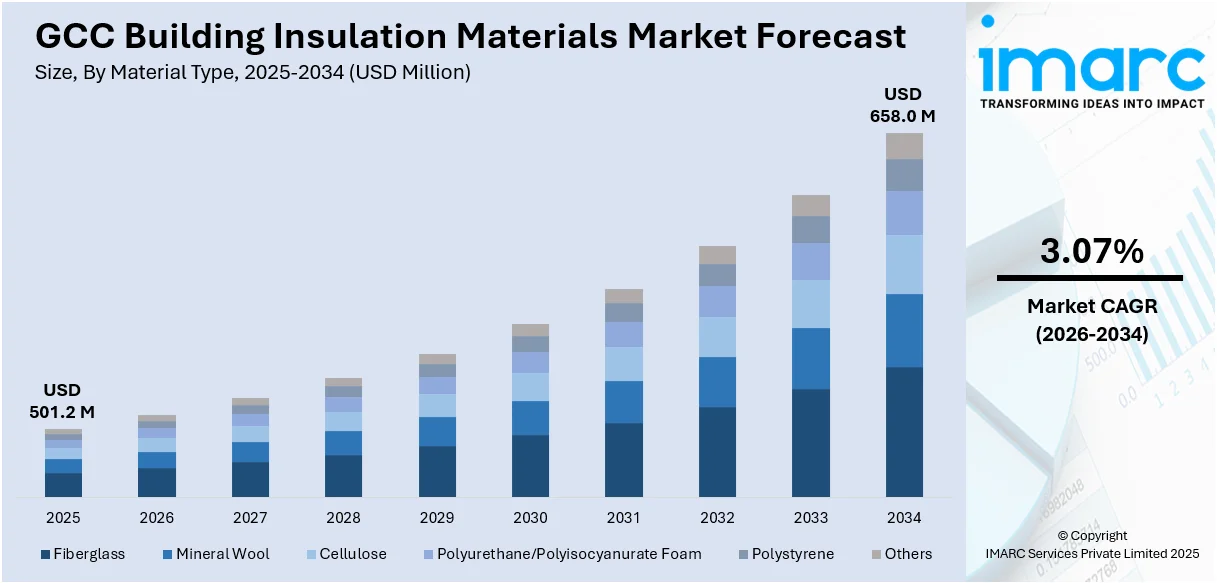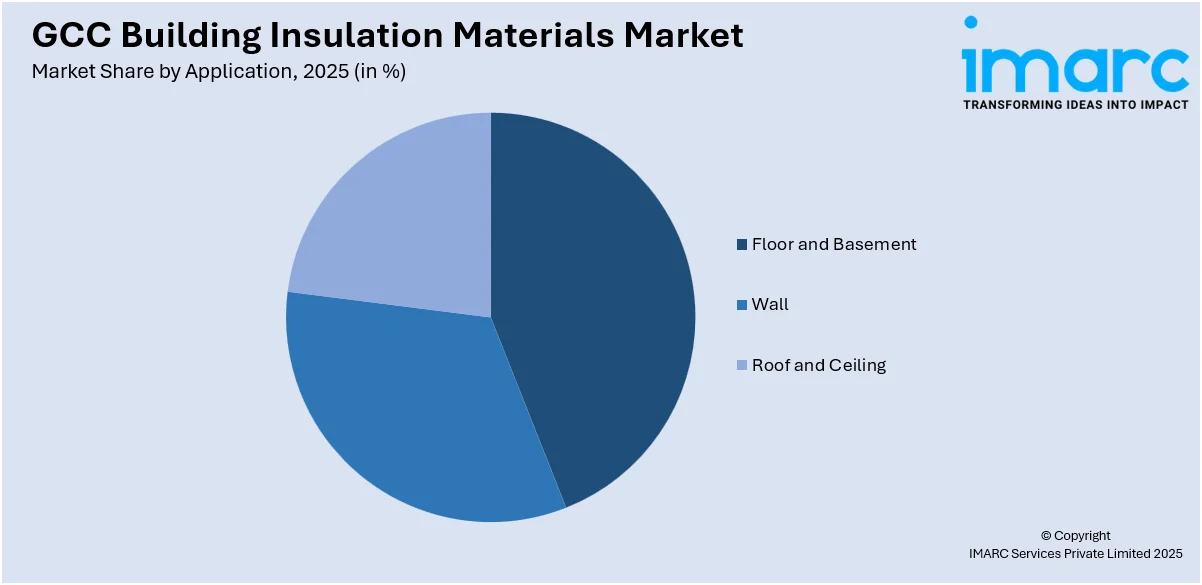
GCC Building Insulation Materials Market Report by Material Type (Fiberglass, Mineral Wool, Cellulose, Polyurethane/Polyisocyanurate Foam, Polystyrene, and Others), Application (Floor and Basement, Wall, Roof and Ceiling), End User (Residential, Non-Residential), and Country 2026-2034
Market Overview:
GCC building insulation materials market size reached USD 501.2 Million in 2025. Looking forward, IMARC Group expects the market to reach USD 658.0 Million by 2034, exhibiting a growth rate (CAGR) of 3.07% during 2026-2034. The launch of numerous initiatives by government bodies promoting energy efficiency and sustainable construction practices is primarily driving the regional market.
|
Report Attribute
|
Key Statistics
|
|---|---|
|
Base Year
|
2025 |
|
Forecast Years
|
2026-2034
|
|
Historical Years
|
2020-2025
|
| Market Size in 2025 | USD 501.2 Million |
| Market Forecast in 2034 | USD 658.0 Million |
| Market Growth Rate (2026-2034) | 3.07% |
Building insulation materials are substances specifically designed to reduce the transfer of heat or sound between different areas of a building. They play a crucial role in enhancing the energy efficiency of structures by minimizing heat loss or gain. Common types of building insulation materials include fiberglass, mineral wool, foam boards, reflective foils, and spray foam. These materials are strategically installed within walls, ceilings, and floors to create a thermal barrier, preventing the exchange of heat and contributing to a more comfortable indoor environment. In addition to thermal insulation, these materials often provide acoustic insulation, reducing sound transmission within the building. Building insulation is a fundamental component in sustainable construction practices, as it helps conserve energy, reduce utility costs, and create more environmentally responsible structures.

To get more information on this market Request Sample
GCC Building Insulation Materials Market Trends:
The GCC building insulation materials market is witnessing transformative trends driven by key drivers that reflect a growing emphasis on energy efficiency and sustainable construction practices in the region. A primary driver is the escalating demand for energy-efficient buildings to combat the challenges posed by rising temperatures in the Gulf. Furthermore, with the rising focus on reducing energy consumption and enhancing thermal comfort, there is a heightened demand for advanced building insulation materials. Apart from this, the development of eco-friendly and high-performance materials is gaining prominence, aligning with the region's commitment to green building standards. Moreover, sustainability remains a central trend, with an increasing focus on environmentally responsible construction practices. Building insulation materials in the GCC are evolving to meet stringent sustainability criteria, incorporating recycled content and reducing environmental impact. Besides this, as the GCC nations prioritize green building regulations and certifications, the market is witnessing a shift towards eco-conscious materials that contribute to reducing the carbon footprint of buildings. Additionally, the rising need for energy efficiency, technological advancements, sustainability, and governmental support are some of the key factors that will bolster the market growth across the GCC in the coming years.
GCC Building Insulation Materials Market Segmentation:
IMARC Group provides an analysis of the key trends in each segment of the market, along with forecasts at the regional and country levels for 2026-2034. Our report has categorized the market based on material type, application, and end user.
Material Type Insights:
- Fiberglass
- Mineral Wool
- Cellulose
- Polyurethane/Polyisocyanurate Foam
- Polystyrene
- Others
The report has provided a detailed breakup and analysis of the market based on the material type. This includes fiberglass, mineral wool, cellulose, polyurethane/polyisocyanurate foam, polystyrene, and others.
Application Insights:

Access the comprehensive market breakdown Request Sample
- Floor and Basement
- Wall
- Roof and Ceiling
A detailed breakup and analysis of the market based on the application have also been provided in the report. This includes floor and basement, wall, and roof and ceiling.
End User Insights:
- Residential
- Non-Residential
The report has provided a detailed breakup and analysis of the market based on the end user. This includes residential and non-residential.
Country Insights:
- Saudi Arabia
- United Arab Emirates
- Qatar
- Kuwait
- Oman
- Bahrain
The report has also provided a comprehensive analysis of all the major regional markets, which include Saudi Arabia, United Arab Emirates, Qatar, Kuwait, Oman, and Bahrain.
Competitive Landscape:
The market research report has also provided a comprehensive analysis of the competitive landscape in the market. Competitive analysis such as market structure, key player positioning, top winning strategies, competitive dashboard, and company evaluation quadrant has been covered in the report. Also, detailed profiles of all major companies have been provided.
GCC Building Insulation Materials Market Report Coverage:
| Report Features | Details |
|---|---|
| Base Year of the Analysis | 2025 |
| Historical Period | 2020-2025 |
| Forecast Period | 2026-2034 |
| Units | Million USD |
| Scope of the Report | Exploration of Historical and Forecast Trends, Industry Catalysts and Challenges, Segment-Wise Historical and Predictive Market Assessment:
|
| Material Types Covered | Fiberglass, Mineral Wool, Cellulose, Polyurethane/Polyisocyanurate Foam, Polystyrene, Others |
| Applications Covered | Floor and Basement, Wall, Roof and Ceiling |
| End Users Covered | Residential, Non-Residential |
| Countries Covered | Saudi Arabia, United Arab Emirates, Qatar, Kuwait, Oman, Bahrain |
| Customization Scope | 10% Free Customization |
| Post-Sale Analyst Support | 10-12 Weeks |
| Delivery Format | PDF and Excel through Email (We can also provide the editable version of the report in PPT/Word format on special request) |
Key Questions Answered in This Report:
- How has the GCC building insulation materials market performed so far and how will it perform in the coming years?
- What is the breakup of the GCC building insulation materials market on the basis of material type?
- What is the breakup of the GCC building insulation materials market on the basis of application?
- What is the breakup of the GCC building insulation materials market on the basis of end user?
- What are the various stages in the value chain of the GCC building insulation materials market?
- What are the key driving factors and challenges in the GCC building insulation materials?
- What is the structure of the GCC building insulation materials market and who are the key players?
- What is the degree of competition in the GCC building insulation materials market?
Key Benefits for Stakeholders:
- IMARC’s industry report offers a comprehensive quantitative analysis of various market segments, historical and current market trends, market forecasts, and dynamics of the GCC building insulation materials market from 2020-2034.
- The research report provides the latest information on the market drivers, challenges, and opportunities in the GCC building insulation materials market.
- Porter's five forces analysis assist stakeholders in assessing the impact of new entrants, competitive rivalry, supplier power, buyer power, and the threat of substitution. It helps stakeholders to analyze the level of competition within the GCC building insulation materials industry and its attractiveness.
- Competitive landscape allows stakeholders to understand their competitive environment and provides an insight into the current positions of key players in the market.
Need more help?
- Speak to our experienced analysts for insights on the current market scenarios.
- Include additional segments and countries to customize the report as per your requirement.
- Gain an unparalleled competitive advantage in your domain by understanding how to utilize the report and positively impacting your operations and revenue.
- For further assistance, please connect with our analysts.
 Request Customization
Request Customization
 Speak to an Analyst
Speak to an Analyst
 Request Brochure
Request Brochure
 Inquire Before Buying
Inquire Before Buying




.webp)




.webp)












